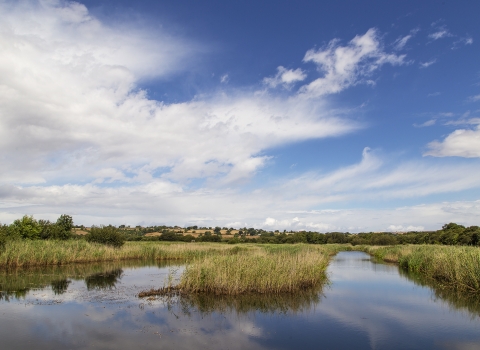
Yarley Fields - Jeff Bevan
Know before you go
Dogs
Visit the 'Dog walking on reserves' page in the Contact section for more information.
When to visit
Opening times
Open at all timesBest time to visit
April to JulyAbout the reserve
Yarley Fields nature reserve lies on the gentle south-facing slope of Yarley Hill. The fields have had little agricultural improvement and have retained a diverse calcareous grassland flora. Typical herbs include Wild Carrot, Hoary Plantain, Bird’s-foot Trefoil, Cowslip, Salad Burnet, Common Knapweed, Agrimony and Ladies Bedstraw. Other plants typical of this type of grassland found here are Common Centuary, Yellow-Wort and Bee Orchid. The uncommon Pale Flax has also been recorded here. Where soils are deeper on the reserve the grassland has abundant crested dog’s-tail grass.
There are areas of wet flush towards the southern end of the reserve where Square-stalked St John’s-Wort, Creeping Jenny, Cuckoo Flower, Common Fleabane, Hard Rush and Parsley Water-Dropwort all occur.
The hedgerows are species-rich with extensive regenerating Elm and unusually, many large specimens of the evergreen shrub Spurge-Laurel. Dormice have been recorded in these hedges.
The site supports a rich invertebrate population with species of butterfly recorded including Brown Argus, Common Blue, Meadow Brown, Gatekeeper, Marbled White and Small Skipper. This is also a good place to look for grasshoppers and crickets including the Meadow Grasshopper, Rufous Grasshopper, Dark Bush Cricket, Speckled Bush Cricket and the Great Green Bush Cricket. All these insects can be very noisy in summer with their zizz zizz calls known as stridulation.
The reserve also has many ant hills in the grassland formed by Yellow Meadow Ants.
Many small birds nest in the hedges including Bullfinches, Song Thrushes and Long Tailed Tits. Green Woodpeckers may be often be seen feeding on ants on the ground in the meadow. Buzzards and Kestrels regularly hunt over the reserve. There are also several Badger setts in the reserves.
Reserve conservation management – Grazing for part or all of the summer depending on seasonal growth rate. Cutting of scrub to stop it encroaching on the grassland. Hedge management.


